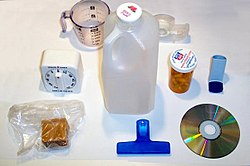Duroplast

Duroplast is a composite thermosetting resin plastic developed by engineer Wolfgang Barthel in 1953[2] in the German Democratic Republic.[3][4] Its production method places it in a similar family as Formica and Bakelite. It is reinforced with fibers (typically waste fabrics from the garment industry) making it a fiber-reinforced plastic similar to fiberglass.
Use and composition
[edit]The German Democratic Republic regularly encountered shortages of steel and had little to no iron reserves of their own. As a result, state-owned automobile manufacturer VEB Sachsenring Automobilwerke Zwickau instead used Duroplast to produce the body shell of the Trabant. Production lasted from 1955 until just after German Reunification in 1991. A light, yet strong material, Duroplast is made of recycled material: cotton waste and phenol resins.[5] Because it is formed in a press, it is more easily applied to volume car production than fiberglass.
Disposal
[edit]Duroplast is difficult to dispose of responsibly, a similar problem encountered with fiberglass. As discarded Trabants began to fill junkyards after 1991, creative solutions were devised for recycling them. One was developed by a Berlin biotechnology company, which experimented with bacteria to consume the body in twenty days.[6][7] Urban legends, depicted in the movie Black Cat, White Cat and described in a song by the Serbian band Atheist Rap, described recycling Duroplast by feeding the cars to pigs, sheep and other farm animals.
In the late 1990s, Sachsenring's developed a disposal solution in which the body shells were shredded and used as an aggregate in cement blocks for pavement construction. This was featured in an episode of the program Scientific American Frontiers on the American PBS TV channel.[5]
Public perception
[edit]The use of Duroplast in Trabants and subsequent GDR jokes and mockery in western auto magazines such as Car and Driver gave rise to an urban myth that the Trabant is made of corrugated cardboard.[8]
References
[edit]- ^ "PBS - Scientific American Frontiers:Previous Shows:Transcripts:Special From Germany". PBS. 2012-03-13. Archived from the original on 2012-03-13.
- ^ ""Doch der erste war er"– Geschichte des Duroplastautos". UNZ (in German). 2015-12-01. Retrieved 2024-01-19.
- ^ Purcell, Russell. "Feature: A Car for a Dollar – The Trabant". www.autos.ca. Retrieved 28 January 2023.
- ^ Pander, Von Jürgen (November 7, 2007). "An East German Icon Hits 50". SPIEGEL International. Retrieved 28 January 2023.
- ^ a b "Duroplast, on season 4, episode 2". Scientific American Frontiers. Chedd-Angier Production Company. 1993–1994. PBS. Archived from the original on 2006-01-01.
- ^ Kumar, Arvind (2004), Environment Contamination & Bioreclamation, APH Publishing, p. 32, ISBN 978-81-7648-587-6.
- ^ Petrány, Máté (13 February 2015). "How Come Duroplast Didn't Become A Thing While Fiberglass Went Big?". Jalopnik. Retrieved 2 July 2015.
- ^ Tony Davis (2005) "Lemon!: Sixty Heroic Automotive Failures", ISBN 1-56025-757-1, Chapter "Trabant P601, p.156-158


